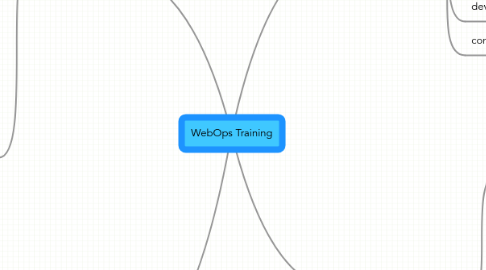
1. specific skills
1.1. skill matrix
1.1.1. who
1.1.2. what skill
1.1.3. existing level
1.1.4. level needed
1.2. what
1.2.1. CSS
1.2.2. XHTML
1.2.3. JavaScript
1.2.4. Dreamweaver
1.2.5. Contribute
1.2.6. graphics
1.2.7. writing and editing for the Web
1.3. how
1.3.1. hands on
1.3.2. practical
1.3.3. intensive
1.3.4. instructor led
1.3.5. online/classroom
2. general background and training (101 course)
2.1. what
2.1.1. basic Web technology
2.1.1.1. URL
2.1.1.2. HTTP
2.1.1.3. HTML
2.1.2. Web page technology
2.1.2.1. XHTML
2.1.2.2. CSS
2.1.2.3. JavaScript
2.1.3. data storage and transfer
2.1.3.1. XML
2.1.3.2. relational databases
2.2. why
2.2.1. common knowledge
2.2.2. better communication
2.2.3. bird's eye view
2.3. how
2.3.1. w3schools tutorials and quizzes
2.3.2. on campus
2.3.3. ST&D (Katrina)
2.3.4. IST
3. high-level skills
3.1. usability
3.2. design
3.3. web analytics
3.4. search engine optimization
3.5. project management
3.6. development methodology
3.7. content management
4. emerging technologies
4.1. what
4.1.1. Web 2.0
4.1.1.1. Michael Stephen's pamphlets on "Web 2.0 & Libraries"
4.1.2. AJAX
4.1.3. Social Software / Online Communities (purposes, uses, rationales)
4.1.3.1. wikis
4.1.3.2. blogs
4.1.3.3. RSS feeds
4.1.3.4. facebook
4.1.4. Library 2.0
4.1.5. next generation catalogue
4.1.6. semantic markup
4.1.6.1. microformats
4.1.6.2. Plain Old Semantic HTML (POSH)
4.1.7. mashups
4.2. how
4.2.1. self training
4.2.1.1. book group
4.2.1.2. hackfest (group project)
4.2.1.2.1. set up beta site
4.2.1.3. guest speakers
4.2.1.3.1. Amanda (McMaster)
4.2.1.3.2. Art Rhyno
4.2.1.3.3. Alan Darnell
4.2.1.3.4. Greg Senema
4.2.1.4. buddies / pairs
